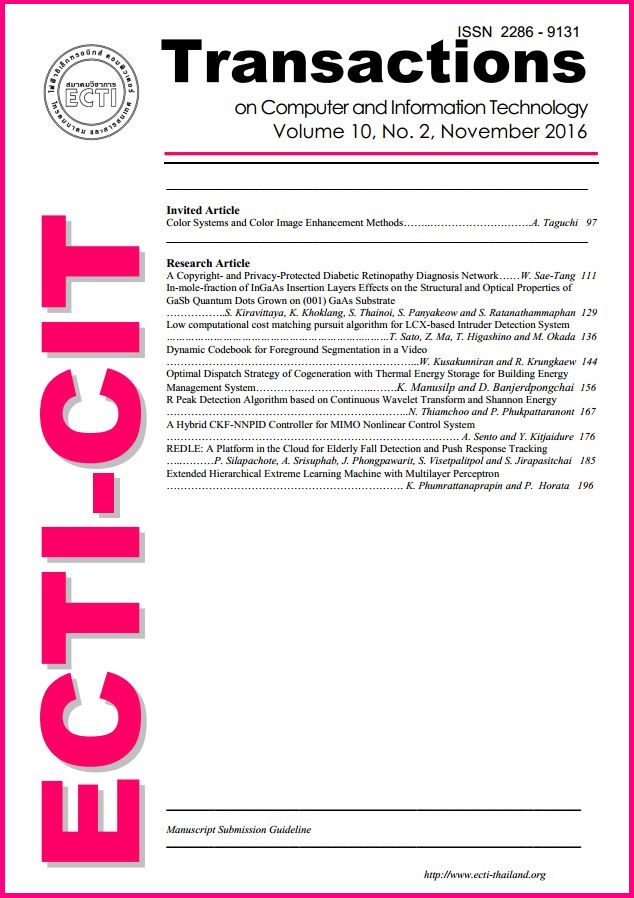REDLE: A Platform in the Cloud for Elderly Fall Detection and Push Response Tracking
Main Article Content
Abstract
Caring for a rapid and ever-increasing older population, providing social support and monitoring emotional wellness, is the most immediate and most urgent challenge prompted by the global aging of baby boomers. Elderly assisted systems do not only promote independent lifestyles, enhancing their quality of life, but also reduce stress and worry of families and friends. While being physically active is beneficial and much encouraged, it does increase the risk of falls. We developed an affordable fall detection and response tracking application on the cloud platform; mobile cloud computing is a major evolution with rising impact in information technology and enterprises. Our system, named REDLE, features push notifications for fall alerts and real-time maps for tracking and providing locations and phone numbers of nearby hospitals. Implemented on Android, it captures signals from an embedded tri-axial accelerometer and a global positioning system sensor. Coupled with an efficient threshold-based fall detection algorithm for instantaneous responses, REDLE achieved a near perfect fall detection rate and accurate tracking. Users enjoyed the smoothness of our interactive interface, and complimented on its ease of use and familiarity.
Article Details
References
A. Srisuphab, P. Silapachote, J. Phongpawarit,
S. Visetpalitpol, and S. Jirapasitchai, “REDLE:
Elderly care on clouds,” in Intl Joint Conference
on Computer Science and Software Engineering,
Khon Kaen, Thailand, July 13-15, 2016.
World Health Organization and Ageing and Life
Course Unit, WHO global report on falls prevention in older age. WHO, 2008.
M. Mubashir, L. Shao, and L. Seed, “A survey
on fall detection: Principles and approaches,”
Neurocomputing, vol. 100, 2013.
International Data Corporation Research, Inc.,
“IDC worldwide mobile phone tracker,” Online:
www.idc.com, accessed on March 18, 2016.
R. Luque et al., “Comparison and characterization of Android-based fall detection systems,”
Sensors, vol. 14, no. 10, October 2014.
H. Kerdegari et al., “Evaluation of fall detection
classification approaches,” in Intl. Conf. on Intelligent and Advanced Systems, June 2012.
F. Sposaro and G. Tyson, “iFall: An android
application for fall monitoring and response,” in
International Conf of IEEE EMBS, Sept 2009.
Instituto Tecnol´ogico y de Energ´ıas Renovables,
S.A, “Fade: fall detector,” Online: apk-dl.com,
accessed on September 24, 2016.
A. D. Basha, I. N. Umar, and M. Abbas, “Mobile
applications as cloud computing: Implementation and challenge,” Intl. Journal of Information
and Electronics Engineering, vol. 4, Jan 2014.
H. Dinh et al., “A survey of mobile cloud
computing: architecture, applications, and approaches,” Wireless Communications and Mobile Computing, vol. 13, October 2011.
S. Komatineni and D. MacLean, Expert Andriod.
USA: Apress, 2013.
A. Hanjura, Heroku Cloud Application Development. Packt Publishing Ltd., April 2014.
K. Chodorow, MongoDB: The Definitive Guide,
nd ed. O’Reilly Media, Inc., May 2013.
Google, Andriod Compatibility Definition, 2015.
A. K. Bourke et al., “Evaluation of waistmounted tri-axial accelerometer based falldetection algorithms during scripted and continuous unscripted activities,” Journal of Biomechanics, vol. 43, no. 15, pp. 3051–57, 2010.
F. Bagal`a et al., “Evaluation of accelerometerbased fall detection algorithms on real-world
falls,” PLoS ONE, vol. 7, no. 5, May 2012.
M. Kangas et al., “Comparison of lowcomplexity fall detection algorithms for body attached accelerometers,” Gait & Posture, vol. 28,
no. 2, pp. 285–291, August 2008.
A. K. Bourke, J. V. O’Brien, and G. M. Lyons,
“Evaluation of a threshold-based tri-axial accelerometer fall detection algorithm,” Gait &
Posture, vol. 26, no. 2, pp. 194–199, July 2007.
A. K. Bourke et al., “Fall-detection through
vertical velocity thresholding using a tri-axial
accelerometer characterized using an optical
motion-capture system,” in IEEE EMBS, 2008.
D. M. Karantonis et al., “Implementation of a
real-time human movement classifier using a triaxial accelerometer for ambulatory monitoring,”
IEEE Trans Inf Technol Biomed, vol. 10, 2006.
E. R. Vieira, R. C. Palmer, and P. H. M. Chaves,
“Prevention of falls in older people living in the
community,” the British Medical Journal (BMJ),
vol. 353:i1419, April 2016.

